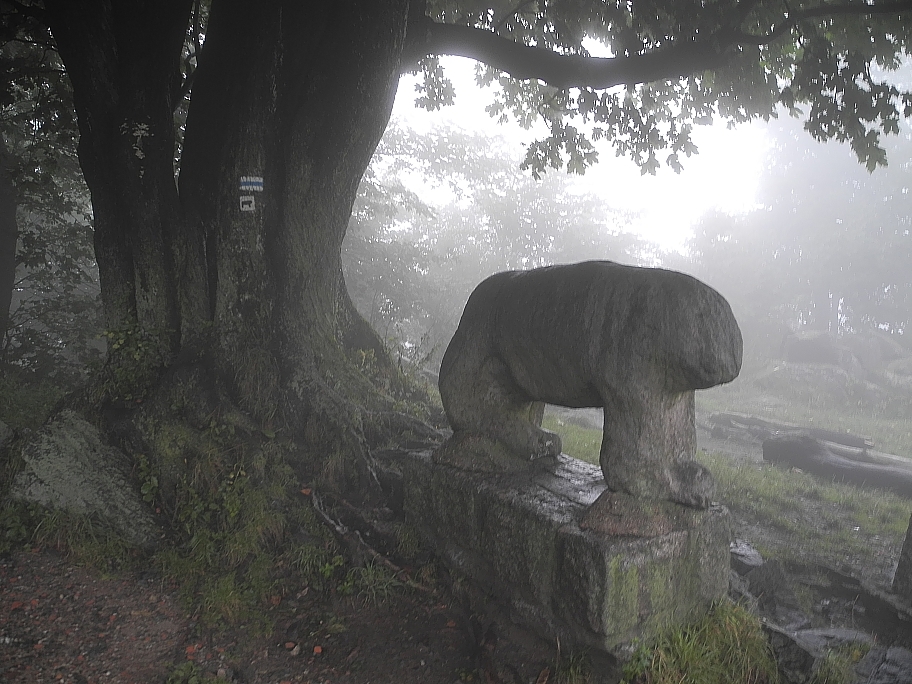
 Misiek ze Ślęży
Misiek ze Ślęży
 Teddy form Ślęża
Teddy form Ślęża

Zdjęcie
 |
POLSKI
|
„Niedźwiedź” (nazywany również „Dzik”) – posąg kultowy powstały prawdopodobnie w okresie lateńskim (około 400–200 roku p.n.e.), umieszczony w 1903 roku na szczycie Ślęży, związany z kręgiem kultury celtyckiej.
Rzeźba wykonana została dość prymitywnie z jasnego granodiorytu biotytowego, tzw. granitu strzeblowskiego, (prawdopodobnie ślężańskiego), jest długa na około 148 cm, o szeroka od 47 do 57 cm, wysoka na około 100 cm przedstawia schematycznie przedstawione zwierzę stojące na czterech łapach, zapewne niedźwiedzia lub dzika z niedźwiedzim ogonem. Pary łap zostały przedstawione jako kolumny. Posąg jest uszkodzony – brak dolnych części łap, a powierzchnia głowy jest zniszczona. Na rzeźbie wyryto dwa znaki: jeden starszy na boku rzeźby (obecnie zatarty) i drugi w postaci ukośnego krzyża na brzuchu, wykonany prawdopodobnie na początku XX wieku.
Posąg powstał prawdopodobnie w okresie lateńskim, w przedziale czasowym od 200 roku p.n.e. do około 400 roku p.n.e. Rzeźba została odkryta przy drodze w okolicy Strzegomia i prawdopodobnie nie była to pierwotna lokalizacja posągu. Możliwe, że znajdował się w jednym ze świętych kręgów na Ślęży. W czasach nowożytnych była znana co najmniej od XVIII wieku, leżała wówczas na boku. Rzeźba stała się bardziej znana w roku 1853, kiedy to została ustawiona pionowo. W 1903 roku posąg przeniesiono na szczyt Ślęży, początkowo w okolice nowego schroniska a następnie w pobliże kościoła Nawiedzenia Najświętszej Maryi Panny, gdzie stoi pod jaworem po dziś dzień.
Aby móc zalogować kesza prześlij do mnie wiadomość z odpowiedziami na poniższe pytania:
- Na ilu kamieniach stoi nasz Misiek?
- Na co spogląda Miś?
- Dołącz zdjęcie wykonane ze skały wystającej po prawej stronie.
- Zaloguj kesza, nie zapomnij o zdjęciu w logu z Tobą lub Twoim GPS:)
 |
ENGLISH
|
'Bear' (also called 'Boar') - a cult statue probably created in the late Lunar period (around 400–200 BC), placed in 1903 at the top of Ślęża, connected with the Celtic culture.
The sculpture was made quite primitively from bright biotite granodorite, so-called Strzeblowski granite, (probably Ślężański), is about 148 cm long, 47 to 57 cm wide, about 100 cm high, schematically depicted an animal standing on four legs, probably a bear or wild boar with a bear tail. Paw pairs are shown as columns. The statue is damaged - no lower parts of the paws, and the surface of the head is damaged. The sculpture carved two characters: one older on the side of the sculpture (now blurred) and the other in the form of an oblique cross on the belly, probably made at the beginning of the 20th century.
The statue was probably built in the late Lien period, in a time range from 200 BC until about 400 BC. The sculpture was discovered along the road near Strzegom and probably this was not the original location of the statue. It is possible that he was in one of the sacred circles of Ślęza. In modern times it has been known at least since the 18th century, it lay on its side at the time. The sculpture became more famous in 1853, when it was placed vertically. In 1903, the statue was moved to the top of Ślęza, initially near the new hostel and then near the Church of the Visitation of the Blessed Virgin Mary, where it stands under the sycamore to this day.
To log in, please send me a message with the answers to the following questions:
- On how many stones our Teddy stands on?
- What is Bear looking at?
- Attach a photo taken from the rock protruding on the right.
- Log the cache, don't forget about the photo with You or your GPS in the log :)
Virtual Rewards 2.0 - 2019/2020
This Virtual Cache is part of a limited release of Virtuals created between June 4, 2019 and June 4, 2020. Only 4,000 cache owners were given the opportunity to hide a Virtual Cache. Learn more about Virtual Rewards 2.0 on the Geocaching Blog.
